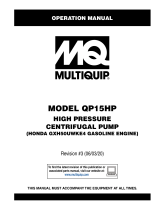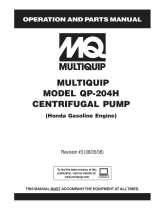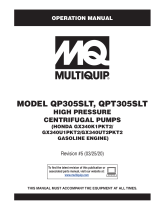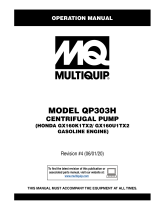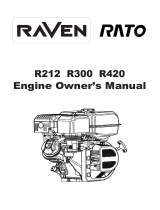Page is loading ...

OPERATION AND PARTS MANUAL
THIS MANUAL MUST ACCOMPANY THE EQUIPMENT AT ALL TIMES.
To fi nd the latest revision of this
publication, visit our website at:
www.multiquip.com
MODEL QP2E
CENTRIFUGAL PUMP
(ROBIN EX130D51111 GASOLINE ENGINE)
Revision #0 (02/12/09)

PAGE 2 — QP2E CENTRIFUGAL PUMP • OPERATION AND PARTS MANUAL — REV. #0 (02/12/09)
PROPOSITION 65 WARNING

QP2E CENTRIFUGAL PUMP • OPERATION AND PARTS MANUAL — REV. #0 (02/12/09) — PAGE 3
NOTES

PAGE 4 — QP2E CENTRIFUGAL PUMP • OPERATION AND PARTS MANUAL — REV. #0 (02/12/09)
TABLE OF CONTENTS
QP2E Centrifugal Pump
Proposition 65 Warning ........................................... 2
Table Of Contents .................................................... 4
Parts Ordering Procedures ...................................... 5
Safety Information ................................................ 6-9
Specifi cations/Dimensions (Pump) ........................ 10
Specifi cations (Engine) .......................................... 11
General Information ............................................... 12
Pump Components ................................................ 13
Basic Engine .......................................................... 14
Inspection .............................................................. 15
Setup ..................................................................... 16
Operation .......................................................... 16-17
Maintenance ..................................................... 18-22
Troubleshooting ................................................ 24-25
Explanation Of Code In Remarks Column............. 26
Suggested Spare Parts ......................................... 27
Component Drawing
Pump Assy. ....................................................... 28-29
Robin EX130D5111 Engine
Crankcase Assy. ............................................... 30-31
Crankshaft, Piston Assy. ...................................... 32-33
Governor Assy. ................................................... 34-35
Camshaft Assy. .................................................. 36-37
Air Cleaner Assy. ................................................ 38-39
Cooling, Starting Assy. ........................................ 40-41
Fuel Tank Assy. ................................................... 42-43
Carburetor Assy. ................................................. 44-45
Flywheel Assy. .................................................... 46-47
Muffl er Assy. ....................................................... 48-49
Cylinder Head Assy. ............................................ 50-51
Accessories Assy. ............................................... 52-53
Terms And Conditions Of Sale — Parts ................ 54

QP2E CENTRIFUGAL PUMP • OPERATION AND PARTS MANUAL — REV. #0 (02/12/09) — PAGE 5
PARTS ORDERING PROCEDURES
www.multiquip.com
Ordering parts has never been easier!
Choose from three easy options:
WE ACCEPT ALL MAJOR CREDIT CARDS!
When ordering parts, please supply:
R Dealer Account Number
R Dealer Name and Address
R Shipping Address (if different than billing address)
R Return Fax Number
R Applicable Model Number
R Quantity, Part Number and Description of Each Part
R Specify Preferred Method of Shipment:
UPS/Fed Ex DHL
N Priority One Tr u ck
N Ground
N Next Day
N Second/Third Day
If you have an MQ Account, to obtain a Username
and Password, E-mail us at: parts@multiquip.
com.
To obtain an MQ Account, contact you
r
District Sales Manager for more information.
Order via Internet (Dealers Only):
Order parts on-line using Multiquip’s SmartEquip website!
N View Parts Diagrams
N Order Parts
N Print Specification Information
Note: Discounts Are Subject To Change
Goto www.multiquip.com and click on
Order Parts
to log in and save!
Use the internet and qualify for a 5% Discount
on Standard orders for all orders which include
complete part numbers.*
Order via Fax (Dealers Only):
All customers are welcome to order parts via Fax.
Domestic (US) Customers dial:
1-800-6-PARTS-7 (800-672-7877)
Fax your order in and qualify for a 2% Discount
on Standard orders for all orders which include
complete part numbers.*
Order via Phone:
Domestic (US) Dealers Call:
1-800-427-1244
Best Deal!
International Customers should contact
their local Multiquip Representatives for
Parts Ordering information.
Non-Dealer Customers:
Contact your local Multiquip Dealer for
parts or call 800-427-1244 for help in
locating a dealer near you.
Note: Discounts Are Subject To Change
Effective:
January 1
st
, 2006
NOTICE
All orders are treated as Standard Orders and will
ship the same day if received prior to 3PM PST.

PAGE 6 — QP2E CENTRIFUGAL PUMP • OPERATION AND PARTS MANUAL — REV. #0 (02/12/09)
SAFETY INFORMATION
FOR YOUR SAFETY AND SAFETY OF OTHERS!
Safety precautions should be followed at all
times when operating this equipment. Failure
to read and understand the safety messages
and operating instructions could result in injury
to yourself and others.
This manual has been developed to
provide complete instructions for the
safe and efficient operation of this
equipment. Refer to the engine
manufacturer’s instructions for data
relative to its safe operation.
Before using this equipment ensure that the operating
individual has read and understood all instructions in this
manual.
SAFETY MESSAGES
The three safety messages shown below will inform you
about potential hazards that could injure you or others.
The safety messages specifically address the level of
exposure to the operator, and are preceded by one of three
words: DANGER, WARNING or CAUTION.
HAZARD SYMBOLS
Potential hazards associated with the operation of this
equipment will be referenced with hazard symbols which
may appear throughout this manual in conjunction with
safety messages.
DANGER
You WILL be
KILLED
or
SERIOUSLY INJURED
if you
DO NOT follow these directions.
WARNING
You CAN be KILLED or
SERIOUSLY INJURED
if you
DO NOT follow these directions.
CAUTION
You CAN be
INJURED
if you DO NOT follow these
directions.

QP2E CENTRIFUGAL PUMP • OPERATION AND PARTS MANUAL — REV. #0 (02/12/09) — PAGE 7
SAFETY INFORMATION
NEVER touch the hot exhaust manifold,
muffler or cylinder. Allow these parts to cool
before servicing engine or pump. Never
operate the engine with heat shields or
guards removed.
ALWAYS allow the engine to cool before adding fuel or
performing service and maintenance functions. Contact
with
hot
components can cause serious burns.
NEVER operate this equipment in any enclosed or narrow
area where free flow of the air is restricted. The engine
of this equipment requires an adequate free flow of
cooling air. If the air flow is restricted it will cause serious
damage to the equipment or
engine and may cause injury
to people and property. The
engine fuel exhaust gases
contain poisonous carbon
monoxide. This gas is
colorless and odorless, and
can cause death if inhaled.
ALWAYS refuel in a well-ventilated area, away from
sparks and open flames. DO NOT fill the fuel tank while
the engine is running or hot. DO NOT overfill tank, since
spilled fuel could ignite if it comes into contact with hot
engine parts or sparks from the ignition system. Store
fuel in approved containers.
ALWAYS use extreme caution when working with
flammable liquids. When refueling, stop the engine and
allow it to cool.
DO NOT smoke around or near the
equipment. Fire or explosion could result
from fuel vapors, or if fuel is spilled on a
hot engine.
NEVER operate the equipment in an
explosive atmosphere or near combustible
materials. An explosion or fire could result
causing severe
bodily harm or even death.
ALWAYS store equipment properly when it is not being
used. Equipment should be stored in a clean, dry location
out of the reach of children.
GENERAL SAFETY
DO NOT operate or service this equipment
before reading the entire manual. The
equipment is to be operated by trained and
qualified personnel only! The equipment is
for industrial use only.
This equipment should not be operated by persons under
18 years of age.
NEVER operate this equipment without proper protective
clothing, shatterproof glasses, respiratory protection,
hearing protection, steel-toed boots and other protective
devices required by the job.
NEVER operate this equipment when not
feeling well due to fatigue, illness or when
under medication.
NEVER operate this equipment under the influence of
drugs or alcohol.
NEVER disconnect any
“emergency or safety
devices.”
These devices are intended for operator safety.
Disconnection of these devices can cause severe injury,
bodily harm or even death! Disconnection of any of these
devices will void all warranties.
NEVER use accessories or attachments that are not
recommended by Multiquip for this equipment. Damage
to the equipment and/or injury to user may result.
Manufacturer does not assume responsibility for any
accident due to equipment modifications. Unauthorized
equipment modification will void all warranties.
Whenever necessary, replace nameplate, operation and
safety decals when they become difficult read.
ALWAYS check the equipment for loosened threads or
bolts before starting.

PAGE 8 — QP2E CENTRIFUGAL PUMP • OPERATION AND PARTS MANUAL — REV. #0 (02/12/09)
SAFETY INFORMATION
■
NEVER run engine without air cleaner. Severe engine
damage may occur.
■
ALWAYS ensure pump is on level ground before use.
■
NEVER pump volatile, explosive,
flammable or low flash point fluids.
These fluids could ignite or explode.
NEVER pump corrosive chemicals or
water containing toxic substances.
These fluids could create serious health
and environmental hazards. Contact
local authorities for assistance.
■
NEVER open the priming plug when pump is hot. Hot
water inside could be pressurized much like the radiator
of an automobile. Allow pump to cool to the touch before
loosening plug. The possibility exists of scalding, resulting
in severe bodily harm.
■
NEVER block or restrict flow from discharge hose.
Remove kinks from discharge line before starting pump.
Operation with a blocked discharge line can cause water
inside pump to overheat.
■
ALWAYS fill the pump casing with water before starting
the engine. Failure to maintain water inside the pump
housing will cause severe damage to the pump and
mechanical seal.
■
In winter drain water from pump housing to prevent
freezing.
■
NEVER tamper with the factory setting of
the engine governor. Personal injury and
equipment damage can result if operating
in speed ranges above the maximum
allowable.
LOADING AND UNLOADING
■
Before lifting, make sure that equipment parts (hook and
vibration insulator) are not damaged and screws are not
loosened or lost.
■
ALWAYS make sure crane or lifting device has been
properly secured to the lifting bail (hook) of the
equipment.
■
NEVER lift the equipment while the engine is running.
■
Use adequate lifting cable (wire or rope) of sufficient
strength.
■
Use one point suspension hook and lift straight upwards.
■
NEVER allow any person or animal to stand underneath
the equipment while lifting.
■
DO NOT lift machine to unnecessary heights.
TRANSPORTING
ALWAYS shutdown engine before transporting.
Tighten fuel tank cap securely and close fuel cock to
prevent fuel from spilling.
ALWAYS tie down the equipment during transport by
securing the equipment with rope.

QP2E CENTRIFUGAL PUMP • OPERATION AND PARTS MANUAL — REV. #0 (02/12/09) — PAGE 9
SAFETY INFORMATION
REFUELING
MAINTENANCE SAFETY
■
NEVER lubricate components or attempt service on a
running machine.
■
ALWAYS allow the machine a proper amount of time to
cool before servicing.
■
Keep the equipment in proper running condition.
■
Fix damage to the equipment immediately and always
replace broken parts.
■
Dispose of hazardous waste properly. Examples of
potentially hazardous waste are used motor oil, fuel and
fuel filters.
■
DO NOT use food or plastic containers to dispose of
hazardous waste.
■
DO NOT pour waste, oil or fuel directly onto the ground,
down a drain or into any water source.
EMERGENCIES
■
ALWAYS know the location of the nearest
fire extinguisher
.
■
ALWAYS know the location of the nearest
first aid kit
.
■
In emergencies,
always
know the location
of the nearest phone or
keep a phone on the job site
.
Also know the phone numbers of the nearest
ambulance
,
doctor
and
fire department
. This
information will be invaluable in case of emergency.

PAGE 10 — QP2E CENTRIFUGAL PUMP • OPERATION AND PARTS MANUAL — REV. #0 (02/12/09)
SPECIFICATIONS/DIMENSIONS (PUMP)
Specifi cations (Pump)Table 1.
Model QP2E
Type Centrifugal Pump
Suction and Discharge Size 2.00 in (51 mm)
Maximum Pumping Capacity
158 gallons/minute
(600 liters/minute)
Max. Lift 25 ft (7.62 meters)
Max. Head 115 ft. (35.0 meters)
Dry Net Weight 53 lbs (24 kg)
QP2E DimensionsFigure 1.

QP2E CENTRIFUGAL PUMP • OPERATION AND PARTS MANUAL — REV. #0 (02/12/09) — PAGE 11
Specifi cations (Engine)Table 2.
Model Robin EX130D51111
Type
Air cooled, 4-cycle single cylinder,
overhead camshaft, gasoline engine
Displacement 7.7 cu. in (126 ml)
Continuous Output
3/3600 kW/rpm
(2.2/3600 HP/rpm)
Maximum Output
4.3/4000 kW/rpm
(3.2/3600 HP/rpm)
Oil Capacity 0.63 quart (0.6 liter)
Fuel Unleaded Automobile Gasoline
Fuel Tank Capacity 2.8 quarts (2.7 liters)
Starting System Recoil Starter
Weight 30.9 lbs (14 kg)
Dimensions (L x W x H)
11.7 x 13.4 x 12.5 in
(297 x 341 x 318 mm)
SPECIFICATIONS (ENGINE)

PAGE 12 — QP2E CENTRIFUGAL PUMP • OPERATION AND PARTS MANUAL — REV. #0 (02/12/09)
GENERAL INFORMATION
DESCRIPTION
The QP2E Centrifugal Pump is designed to handle all
types of clear water applications. It is ideal for residential
use such as dewatering basements and swimming pools.
Both the suction and discharge ports on the pump use a
2-inch diameter opening, which allows the pump to pump
at a rate of approximately 158 gallons/minute (gpm) or 600
liters/minute (lpm).
Centrifugal or self-priming pumps are designed to purge
air from the suction line and create a partial vacuum in the
pump body. The reduced atmospheric pressure inside the
pump allows water to fl ow through the suction line and
into the pump body. The centrifugal force created by the
rotating impeller pressurizes the water and expels it from
the pump.
ENGINE
This centrifugal pump is powered by an air-cooled 4-cycle,
single cylinder Robin EX130D51111 gasoline engine.
STANDARD CENTRIFUGAL PUMP
Standard centrifugal pumps provide an economical choice
for general purpose dewatering. These types of pumps
should only be used in clear water applications (agricultural,
industrial, residential) as they have a limited solid handling
capability of only 10% by volume.
SUCTION LIFT
This pump is capable of suction lifts up to 25 feet at sea
level. For optimal suction lift performance keep the suction
hose or line as short as possible. In general, always place
the pump as close to the water as possible.
PUMP SUPPORT
The pump should always be placed on solid stationary
ground, on a level position.
NEVER place the pump on soft soil. The suction hose or
pipe connection should always be checked for tightness
and leaks. A small suction leak in the hose or fi ttings could
prevent the pump from priming.
ELEVATION
Higher elevations will effect the performance of the pump.
Due to less atmospheric pressure at higher altitudes,
pumps do not have the priming ability that they have at
sea level. This is due to the “thinner air” or lack of oxygen
at higher altitudes.
A general rule of thumb is that for every 1,000 feet of
elevation above sea level a pump will lose one foot of
priming ability.
For example, in Flagstaff, Arizona where the elevation is
approximately 7,000 feet, the pump would have a suction
lift of only 18 feet rather than the 25 feet at sea level. Table 3
shows suction lift at various elevations.
Table 4 shows percentage drops in performance as
elevation increases.
Suction Lift at Various ElevationsTable 3.
Altitude
Ft (Meters)
Suction Lift in Feet (Meters)
Sea Level
10.0
(3.048)
15.0
(4.572)
20.0
(6.096)
25.0
(7.620)
2,000 (610)
8.80
(2.680)
13.2
(4.023)
17.6
(5.364)
22.0
(6.705)
4,000 (1,219)
7.80
(2.377)
11.7
(3.566)
15.6
(4.754)
19.5
(5.943)
6,000 (1,829)
6.90
(2.103)
10.4
(3.169)
13.8
(4.206)
17.3
(5.273)
8,000 (2,438)
6.20
(1.889)
9.30
(2.834)
12.4
(3.779)
15.5
(4.724)
10,000 (3,048)
5.70
(1.737)
8.60
(2.621)
11.4
(3.474)
14.3
(4.358)
Performance Loss at Various ElevationsTable 4.
Altitude
Ft (Meters)
Discharge Flow Discharge Head
Sea Level 100% 100%
2,000 (610) 97% 95%
4,000 (1,219) 95% 91%
6,000 (1,829) 93% 87%
8,000 (2,438) 91% 83%
10,000 (3,048) 88% 78%

QP2E CENTRIFUGAL PUMP • OPERATION AND PARTS MANUAL — REV. #0 (02/12/09) — PAGE 13
PUMP COMPONENTS
Figure 2 shows a typical application using the QP2E
centrifugal pump. Please note that this pump is intended
for the removal of clean water.
QP2E Pump ApplicationFigure 2.
Pump 1. — A 2-inch centrifugal pump used in general de-
watering applications. Typical dewatering applications
consist of dewatering basements and swimming
pools.
Fill Cap 2. — Prior to operation, the pump casing should
be fi lled with water. Remove this cap to add water to
the pump. After the initial prime, a suffi cient amount of
water will be retained in the casing so that the operator
will not need to re-prime later.
If the casing is dry or has insuffi cient water, the pump
will have difficulty in priming which could lead to
premature mechanical seal wear thus causing damage
to the pump.
Discharge Port 3. — Connect a 2-inch discharge hose
to this port.
Worm Clamp 4. — Used to secure the hose to the inlet
and outlet ports on the pump. Use two clamps to secure
the hose on the inlet side of the pump.
Discharge Hose 5. — Connect this flexible rubber
hose to the discharge port on the pump. Make sure
that the hose lays fl at and is not kinked. Use only
recommended type discharge hose. Contact Multiquip
parts department for ordering information.
Suction Port 6. — Connect a 2-inch inlet hose to this
port. Use two worm clamps to secure the hose.
Suction Hose 7. — Connect this fl exible rubber hose to
the suction port on the pump. Make sure that the hose
lays fl at and is not kinked. Use only recommended type
suction hose. Contact Multiquip Parts Department for
ordering information.
Drain Plug 8. — Remove this plug to drain water from
the pump.
Strainer 9. — Always attach a strainer to bottom side of
the suction hose to prevent large objects and debris
from entering the pump. Strainer should be positioned
so that it will remain completely under water. Running
the pump with the strainer above water for long periods
can damage pump.

PAGE 14 — QP2E CENTRIFUGAL PUMP • OPERATION AND PARTS MANUAL — REV. #0 (02/12/09)
BASIC ENGINE
1
2
3
4
5
6
8
7
9
10
Robin Engine ComponentsFigure 3.
The engine (Figure 3) must be checked for proper
lubrication and fi lled with fuel prior to operation. Refer
to the manufacturer's engine manual for instructions and
details of operation and servicing.
Fuel Filler Cap 1. — Remove this cap to add unleaded
gasoline to the fuel tank. Make sure cap is tightened
securely. DO NOT over fi ll.
Throttle Lever 2. — Used to adjust engine RPM speed
(lever advanced forward - SLOW, lever back toward
operator - FAST).
Engine ON/OFF Switch 3. — ON position permits engine
starting, OFF position stops engine operations.
Recoil Starter (pull rope) 4. — Manual-starting method.
Pull the starter grip until resistance is felt, then pull
briskly and smoothly.
Fuel Valve Lever 5. — OPEN to let fuel fl ow, CLOSE to
stop the fl ow of fuel.
DANGER
Adding fuel to the tank should be done
only when the engine is stopped and has
had an opportunity to cool down. In the
event of a fuel spill, DO NOT attempt to
start the engine until the fuel residue has
been completely wiped up and the area surrounding
the engine is dry.
Choke Lever 6. — Used in the starting of a cold engine,
or in cold weather conditions. The choke enriches the
fuel mixture.
Air Cleaner 7. — Prevents dirt and other debris from
entering the fuel system. Remove wing-nut on top of
air fi lter canister to gain access to fi lter element.
Spark Plug 8. — Provides spark to the ignition system.
Set spark plug gap to 0.6 - 0.7 mm (0.028 - 0.031 inch).
Clean spark plug once a week.
Muffl er 9. — Used to reduce noise and emissions.
Fuel Tank 10. — Holds unleaded gasoline. For additional
information refer to engine owner's manual.
NOTICE
Operating the engine without an air filter, with a
damaged air fi lter, or a fi lter in need of replacement
will allow dirt to enter the engine, causing rapid engine
wear.
WARNING
Engine components can generate extreme
heat. To prevent burns, DO NOT touch
these areas while the engine is running
or immediately after operating. NEVER
operate the engine with the muffler
removed.

QP2E CENTRIFUGAL PUMP • OPERATION AND PARTS MANUAL — REV. #0 (02/12/09) — PAGE 15
INSPECTION
BEFORE STARTING
Read safety instructions at the beginning of manual.1.
Clean the pump, removing dirt and dust, particularly the 2.
engine cooling air inlet, carburetor and air cleaner.
Check the air fi lter for dirt and dust. If air fi lter is dirty, 3.
replace air fi lter with a new one as required.
Check carburetor for external dirt and dust. Clean with 4.
dry compressed air.
Check fastening nuts and bolts for tightness.5.
ENGINE OIL CHECK
To check the engine oil level, place the pump on secure 1.
level ground with the engine stopped.
Remove the fi ller dipstick from the engine oil fi ller hole 2.
(Figure 4) and wipe clean.
Engine Oil Dipstick (Removal)Figure 4.
Insert and remove the dipstick without screwing it 3.
into the fi ller neck. Check the oil level shown on the
dipstick.
If the oil level is low (Figure 5), fi ll to the edge of the oil 4.
fi ller hole with the recommended oil type (Table 4).
Maximum oil capacity is 0.63 quarts (0.60 liters).
Engine Oil Dipstick (Oil Level)Figure 5.
FUEL CHECK
Remove the gasoline cap located on top of fuel tank.1.
Visually inspect to see if the fuel level is low. If fuel is 2.
low, replenish with unleaded fuel.
When refueling, be sure to use a strainer for fi ltration. 3.
DO NOT top-off fuel. Wipe up any spilled fuel
immediately!
Oil TypeTable 5.
Season Temperature Oil Type
Summer 25° C or higher SAE 10W-30
Spring/Fall 25° C - 10° C SAE 10W-30/20
Winter 0° C SAE 10W-10
DANGER
Adding fuel to the tank should be done
only when the engine is stopped and has
had an opportunity to cool down. In the
event of a fuel spill, DO NOT attempt to
start the engine until the fuel residue has
been completely wiped up and the area surrounding
the engine is dry.

PAGE 16 — QP2E CENTRIFUGAL PUMP • OPERATION AND PARTS MANUAL — REV. #0 (02/12/09)
OPERATION
SETUP
Place pump as near to water as possible, on a fi rm 1.
fl at, level surface.
To prime pump, remove fi ll cap (Figure 2) and fi ll pump 2.
casing with water. If the pump casing is not fi lled with
water before starting, it will not begin pumping.
Attach suction and discharge hoses to the pump. 3.
Check that all hoses are securely attached to the pump.
Make certain suction hose (Figure 2) does not have
any air leakage. Tighten hose clamps and couplings
as required.
It is recommended that 2 clamps be used when 4.
securing the suction hose to the inlet side (suction)
of the pump.
Remember suction hoses must be rigid enough not to 5.
collapse when the pump is in operation.
Check that the discharge hose (Figure 2) is not 6.
restricted. Place hose so that it lays as straight as it is
possible on the ground. Remove any twists or sharp
bends from hose which may block the fl ow of water.
The discharge hose is usually a collapsible (thin-7.
walled) hose. However if a thin-walled discharge hose
is not available, a rigid suction hose can be substituted
in its place.
Make sure the suction strainer (Figure 2) is clean 8.
and securely attached to the water end of the suction
hose. The strainer is designed to protect the pump
by preventing large objects from being pulled into the
pump.
NOTICE
Suction and discharge hoses are available from
Multiquip. Contact your nearest dealer for more
information.,
CAUTION
The strainer should be positioned so it will remain
completely under water. Running the pump with the
strainer above water for long periods can damage the
pump.
INITIAL STARTUP
Place the fuel valve lever (Figure 6) in the "ON" position.9.
Fuel Valve LeverFigure 6.
Place the Engine ON/OFF switch (Figure 7) in the "ON" 10.
position.
Engine ON/Off SwitchFigure 7.
Place the Choke Lever (Figure 8) in the "OPEN" 11.
position.
Choke LeverFigure 8.
CAUTION
DO NOT attempt to start the engine unless the pump
has previously been primed with water. Severe pump
damage will occur if pump has not been primed.
FUEL
LEVER
ENGINE
ON/OFF
SWITCH
ON
OFF
Nnnn
OPEN
CLOSED
CHOKE
LEVER

QP2E CENTRIFUGAL PUMP • OPERATION AND PARTS MANUAL — REV. #0 (02/12/09) — PAGE 17
OPERATION
Place the throttle lever (Figure 9) halfway between fast 12.
and slow.
Throttle LeverFigure 9.
Grasp the starter grip (Figure 10) and slowly pull it out. 13.
The resistance becomes the hardest at a certain
position, corresponding the compression point. Rewind
the rope a little from that point and pull out sharply.
Starter GripFigure 10.
If the engine has started, slowly return the choke lever 14.
(Figure 8) to the CLOSED position. If the engine has
not started repeat steps 1 through 5.
Before the pump is put into operation run the engine 15.
for 3-5 minutes.
NOTICE
The CLOSED position of the choke lever enriches the
fuel mixture for starting a COLD engine. The OPEN
position provides the correct fuel mixture for normal
operation after starting, and for restarting a warm
engine.
THROTTLE
LEVER
FAST
SLOW
STARTER GRIP
CAUTION
DO NOT pull the starter rope all the way to the end.
DO NOT release the starter rope after pulling. Allow it
to rewind as soon as possible.
Check for fuel leaks and noises that would be 16.
associated with a loose component.Check for leaks
between pump and engine. If water is leaking between
the pump and engine housing, the seal inside the
pump may be worn or damaged. Continued operation
of the pump is not recommended. Further usage of the
pump under these conditions may cause severe water
damage to engine.
OPERATION
Once the engine has started, move the engine throttle 1.
lever quickly to the fast position to begin pumping. If
water is not fl owing out of the discharge port, turn off
the engine and check for and clear any obstructions
within the suction hose.
STOPPING THE ENGINE
Place the throttle lever (Figure 9) in slow position, and 1.
listen for the engine speed to decrease.
Place the Engine ON/OFF switch (Figure 7) in the 2.
"OFF" position.
Place the fuel valve lever (Figure 6) in the "3. OFF"
position.
WARNING
Water must always be fl owing through the pump casing
while the engine is running. Loss of fl ow may be the
result of a loss of prime, restricted water fl ow or a dead-
head situation. Please note that in such a condition,
water in the pump can reach temperatures of 150-200°F
in 15 to 20 minutes. This can cause serious burns if
this hot water comes into contact with unprotected skin.
Before touching or opening the fi ll plug or drain plug,
fi rst turn off the engine and allow the pump casing to
cool to the touch, and then open the pump carefully.
Be cautious of any built up water pressure.
CAUTION
ALWAYS run engine at full speed while pumping.

PAGE 18 — QP2E CENTRIFUGAL PUMP • OPERATION AND PARTS MANUAL — REV. #0 (02/12/09)
MAINTENANCE
PUMP VACUUM TEST
To perform the pump vacuum test do the following:
Remove the pump fi ll cap (Figure 2), and fi ll the pump 1.
with water.
Start the engine as outlined in the initial start-up 2.
section, and wait for the pump to begin pumping.
As shown in Figure 11, place a water hose inside 3.
the discharge opening of the pump, and turn on the
water. This fl ow of water into the discharge opening
will prevent the pump from running dry.
Place the Pump Vacuum Tester (P/N 7000030) over 4.
the pump suction (inlet) opening (Figure 11) with the
vacuum gauge facing upwards. It may be necessary to
apply a small amount of water around the rubber seal
of the vacuum tester to make a good suction fi t.
Check and make sure that there are no air leaks 5.
between the vacuum tester and the inlet port on the
pump. If air leaks are present reset vacuum tester.
Run the pump for a few minutes while monitoring the 6.
vacuum gauge. If the gauge indicates a reading
between -25 and -20 in. Hg. (inches of mercury) then
it can be assumed that the pump is working correctly.
CAUTION
DO NOT attempt to start the engine unless the pump
has previously been primed with water. Severe pump
damage will occur if pump has not been primed.
NOTICE
25 in. Hg (inches of mercury) translates into 25 feet of
lift at sea level.
If the vacuum tester gauge indicates a reading below 7.
-20 in. Hg, it can then be assumed that the pump is
not functioning correctly, and corrective action needs
to be taken.
To test the fl apper valve, shut down the engine. The 8.
vacuum tester should remain attached to the pump
suction inlet port by vacuum. This indicates the pump's
fl apper valve is seating properly to hold water in the
suction hose when the engine is stopped. This prevents
backfl ow and allows for faster priming when the engine
is restarted.

QP2E CENTRIFUGAL PUMP • OPERATION AND PARTS MANUAL — REV. #0 (02/12/09) — PAGE 19
MAINTENANCE
Pump Vacuum TesterFigure 11.
NOTICE
Vacuum test may be performed without water fl owing
through the discharge port. However, it is recommended
to have water fl owing to prevent any heat-up.

PAGE 20 — QP2E CENTRIFUGAL PUMP • OPERATION AND PARTS MANUAL — REV. #0 (02/12/09)
ENGINE MAINTENANCE
Perform engine maintenance procedures as listed in
Table 6:
Inspection/MaintenanceTable 6.
DESCRIPTION (3) OPERATION
BEFORE
FIRST
MONTH
OR
10 HRS
FIRST
25
HRS
EVERY
3
MONTHS
OR
25 HRS
EVERY
6
MONTHS
OR
50 HR
S
EVERY
YEAR
OR
100 HRS
EVERY
YEAR
OR
200 HRS
EVERY
2 YEARS
OR
200 HRS
Engine Oil
Check X X
Change X
Air Cleaner
Check X
Change X (1)
Nuts and Bolts
Re-Tighten If
Necessary
X
Spark Plug
Check-Clean X
Replace X
Cooling Fins Check X
Spark Arrester Clean X
Fuel Tank Clean X
Fuel Filter Check X
Idle Speed Check-Adjust X (2)
Valve Clearance Check-Adjust X X X (2)
Fuel lines Check Every 2 years (replace if necessary) (2)
(1) Service more frequently when used in DUSTY areas.
(2) These items should be serviced by your service dealer,
unless you have the proper tools and are mechanically profi cient.
Refer to the Robin shop Manual for service procedures.
(3) For commercial use, log hours of operation to determine
proper maintenance intervals.
MAINTENANCE
/
